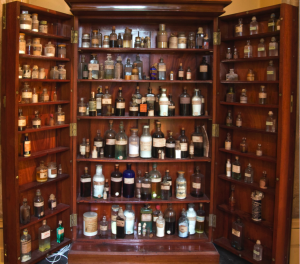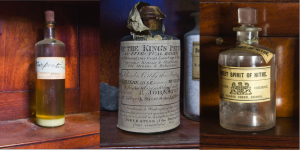Isabel Wiltshire reflects on this summer’s interdisciplinary research internship, which brought chemistry together with the history of medicine; the project was supervised by Dr Victoria Bates (history) and Dr Jenny Slaughter (chemistry).
How can chemistry be used to write history? This was the question that I set out to answer this summer, using the contents of a Victorian medicine cabinet discovered at Tyntesfield House in North Somerset. This cabinet was the property of the Gibbs family who were prosperous traders and contains over 150 bottles; the contents of the cabinet ranged from medicinal ingredients to prescriptions and ‘quack’ medicines. The School of Chemistry of the University of Bristol has been involved in the safe cleaning of the bottles contained within it, many of which contained poisons and dangerous substances. I am a third year undergraduate chemistry student and have investigated the cabinet as part of an interdisciplinary project between the School of Chemistry and the Department of History.
 The cabinet – as it was found by National Trust Staff
The cabinet – as it was found by National Trust Staff
It has become apparent, as I reach the end, that this project was far more history-based than chemistry-based, despite my initial introduction to it being through the School of Chemistry. This was inevitable really, when dealing with a Victorian artefact. However, when starting out, the sheer size of the task was daunting: I had never done historical research or studied history at any great length. Where to start? I went about the historical research the way I would go about researching a lab report. After three years of studying chemistry, I sure know how to type a keyword into a database. It turned out, of course, to be a lot harder than that. There was in fact very little literature on the exact area of history I was interested in: self-care in Victorian England. I wanted to know what happened after the doctor left, or before he would even have been called out. I started big, trying to gain a general idea of what medicine and sickness were like at the time, because I really don’t have a historical backing to start from; this process was pretty much the equivalent of reading a chemistry textbook before starting a research project because you don’t know what molecules are. I could then start going into detail about particular areas that, together, would give me an idea of how Victorians treated themselves when ill. This research covered pharmacists, opium and quackery, to name but a few, and focused initially on books and papers published by historians. Finally I got down to the primary sources, many of which are quite different from a primary source in science. My historical primary sources included diary entries and newspapers, whereas a primary source in chemistry would generally be a journal article, peer-reviewed and presenting the latest research in that field. I found the historical primary sources to be often amusing and horrifying in equal measures (I would recommend the seminal tome, Memoirs of a Stomach to anyone).  It was certainly a challenge to apply my chemistry skills to a historical problem, but my background as a science student didn’t hinder my research. Any skills I have in research I believe I obtained by studying chemistry. Despite disciplinary differences, in both chemistry and history it is possible to take a medical cabinet as a ‘source’: a starting point for research. By using my skills in chemistry to analyse the medicine itself, instead of just historical books about medicine, I could gain unique insights into the history of medicine. The historical research led me to choose three bottles from the cabinet to sample. Each would be an example of a different aspect of self-care and the medical marketplace in Victorian Britain. Determining the different categories came from the observations of the different bottles and the historical research undertaken. Both complemented each other: seeing that the cabinet contained many tinctures and spirits of herbs and flowers correlated with contemporary and historiographical reports of traditional medicines still being used in ‘modernity’, for instance. The interdisciplinary aspect of the project was essential at this point: chemical analysis was important for identifying what types of medicines were being used; research into the preparation and uses of the different medicines was essential for making this analysis historiographical meaningful. Here, chemistry and history needed to work in tandem. The meeting of chemistry and history is possibly a strange one, but I believe that there is much to be learned by utilizing scientific resources, notably analytical techniques, to aid historical research.
It was certainly a challenge to apply my chemistry skills to a historical problem, but my background as a science student didn’t hinder my research. Any skills I have in research I believe I obtained by studying chemistry. Despite disciplinary differences, in both chemistry and history it is possible to take a medical cabinet as a ‘source’: a starting point for research. By using my skills in chemistry to analyse the medicine itself, instead of just historical books about medicine, I could gain unique insights into the history of medicine. The historical research led me to choose three bottles from the cabinet to sample. Each would be an example of a different aspect of self-care and the medical marketplace in Victorian Britain. Determining the different categories came from the observations of the different bottles and the historical research undertaken. Both complemented each other: seeing that the cabinet contained many tinctures and spirits of herbs and flowers correlated with contemporary and historiographical reports of traditional medicines still being used in ‘modernity’, for instance. The interdisciplinary aspect of the project was essential at this point: chemical analysis was important for identifying what types of medicines were being used; research into the preparation and uses of the different medicines was essential for making this analysis historiographical meaningful. Here, chemistry and history needed to work in tandem. The meeting of chemistry and history is possibly a strange one, but I believe that there is much to be learned by utilizing scientific resources, notably analytical techniques, to aid historical research.
